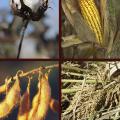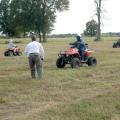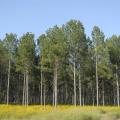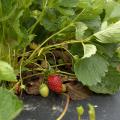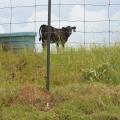News From 2015
STARKVILLE, Miss. -- Mississippi State University entomologist John Guyton actually wears them on special occasions in a tie, and some people collect them for science experiments, but homeowners typically want nothing to do with termites.
Termites are estimated to cause $40 billion in damage to wooden structures every year. In the U.S., that figure is $2 billion to $3 billion, and several million dollars are lost to termites each year in Mississippi.
BAY SPRINGS, Miss. -- When Hope James decided to stay home with her children and offer child care to parents in the Bay Springs area, she had no idea her decision would result in her business being recognized as one of the top in the state.
James, owner of Tot Shop of Bay Springs, recently received a 5-star rating from the Quality Rating and Improvement System. The evaluation is based on a national standard and scale, and James’s is one of the few centers in the state to achieve this level of quality.
With all of the annual flowering plants being displayed in garden centers, you might be distracted and pass right by the gorgeous foliage colors of caladium. And this makes the caladiums feel bad.
Caladiums are among the most misunderstood plants in landscapes and gardens. Do you plant them in the sun, shade or some kind of mixed sun and shade? The answer will be revealed later.
STARKVILLE, Miss. -- Mississippi cotton will need a warm, dry fall to counter the mostly wet spring and thrive in 2015.
Darrin Dodds, Mississippi State University Extension Service cotton specialist and research professor in the MSU Department of Plant and Soil Sciences, said heavy springtime rains caused planting delays for the third straight year. Generally, a week-long dry spell in mid-May has been sandwiched between extended periods of consistent rainfall. Dodds said producers made quick and substantial progress planting during that interim.
STARKVILLE, Miss. -- Mother Nature may deserve most of the credit, but management decisions by some “boots on the ground” also contributed to Mississippi’s record yields in cotton, soybeans, corn and rice in 2014.
The U.S. Department of Agriculture recently released the official cotton yield averages, placing Mississippi fields at an all-time high of 1,232 pounds per acre. Cotton joins other 2014 crops with records, including soybeans at 52 bushels per acre, corn at 185 bushels per acre and rice at 7,420 pounds per acre.
STARKVILLE, Miss. -- Riding all-terrain vehicles is a fun adventure until tragedy strikes, but simple practices can keep riders safe.
Jesse Wilson, a high school senior from Lowndes County, has firsthand experience with an ATV disaster. Wilson was driving up a steep ditch when his ATV fell back on top of him because of excess weight on the back of the vehicle. He was not wearing any safety gear at the time. Wilson broke his shoulder because of this accident, and had to have surgery.
STARKVILLE, Miss. -- Drinking a beverage that tastes delicious and has good nutritional value is like having your cake and eating it, too.
Brent Fountain, associate professor of food science, nutrition and health promotion with the Mississippi State University Extension Service, said milk is a good source of protein. Protein provides the nutrients the body needs to build and repair bones, muscles, cartilage, skin and blood. Milk is also a good carbohydrate source, providing the body with energy. Calcium and vitamin D are also important nutrients found in milk.
STARKVILLE, Miss. – I was born and raised in the South, so it’s hard for me to imagine a world without trees.
Bottomland hardwoods, mixed oak and hickory forests, and pine savannahs are all iconic scenes of Mississippi’s wild lands. Trees are not only a beautiful fixture of the Southeastern landscape; they are also very important economically and ecologically. Whether you realize it or not, trees impact our lives in many ways. The houses we live in, the furniture we sit in and sleep on, and the paper products we use every day are all derived from trees.
May is Older Americans Month…
STARKVILLE, Miss. -- Even people who can eat almost anything when they are young will eventually begin monitoring their calories, cholesterol, fiber, sodium or sugar as they get older.
Brent Fountain, associate professor of human nutrition with the Mississippi State University Extension Service, said metabolism typically slows down as people age. The amount of calories a person needs usually goes down, and the percentage of protein he or she needs goes up.
GOODMAN, Miss. -- Farmers and producers can learn how to increase farm profits during a series of field days at the Alliance for Sustainable Agricultural Production Farm near Goodman.
Ellen Polishuk, a long-time Virginia vegetable grower, will return for part two of the Growing Farm Profits program on June 19. Her farm served as a case study in part one of this session earlier in 2015.
Topics include practical applications of profit management and decision making in the field. Participants also will tour two local farms that use these strategies.
RAYMOND, Miss. – Seemingly endless rains this spring are challenging Mississippi’s strawberry crop.
“The frequent rains we had in the last few months put pressure on the bloom and fruit quality,” said Bill Evans, a horticultural researcher with the Mississippi Agricultural and Forestry Experiment Station. “In April alone, we got more than 7 inches of rain.”
May is Older Americans Month …
STARKVILLE, Miss. -- Older Americans, along with their caregivers and families, can better navigate legal and financial waters related to aging by making appropriate plans, protecting their identities and being aware of scams.
Foxglove can create a dramatic effect with its tall spires of flowers but is an underused plant in Mississippi, especially in the southern counties.
Foxglove, known botanically as Digitalis, is a member of a somewhat curious group of plants called biennials. These plants typically take two years to complete their lifecycles. After germination, the plants only grow vegetatively (leaves, stems and roots), usually forming a low-growing rosette.
STARKVILLE, Miss. -- Summer is a critical season for white-tailed deer, especially in the Deep South.
Adult does are lactating, fawns are growing, and bucks are producing new antlers. The nutritional needs of each developing animal are high. If landowners and managers are going to plant warm-season food plots of quality legumes, they should plant between mid-April and early June. These forages can be an excellent way to supplement the natural food sources provided by Mother Nature in a well-maintained habitat.
May is Older Americans Month …
Eating a bowl of cereal for dinner can demonstrate the many factors that contribute to food insecurity for older Americans.
“Sometimes, an older person chooses a bowl of cereal for dinner because it’s quick, easy, inexpensive, available and fairly healthy,” said Sylvia Byrd, a professor at Mississippi State University. “Convenience, cost, ease of use and access are all major factors that influence food security.”
STARKVILLE, Miss. -- Mississippi farmers should not take the state’s rich soil for granted, but the question of the best way to treat this valuable resource sparks debate.
“Soil can be thought of as a living organism that must be kept healthy to provide some of the crop requirements and make efficient use of inputs, especially fertilizer,” said Larry Oldham, soil specialist with the Mississippi State University Extension Service.
STARKVILLE, Miss. -- Four Mississippi State University professors participated in the joint conference of the Association of International Agricultural and Extension Education and the European Seminar on Extension and Education in the Netherlands in late April.
STARKVILLE, Miss. -- Southern farmers may never win the battle against imported fire ants, but aggressive tactics can slow the pests’ invasion, reduce damage and prevent further spread across the United States.
Jane Parish is an Extension/research professor with the Mississippi State University Extension Service and the Mississippi Agricultural and Forestry Experiment Station. She said cattle and hay producers have learned to live with and work around the troublesome ants since the pests arrived in the state almost a century ago.
NEWTON, Miss. -- Producers can learn about production and management methods for hay and other forage crops during a June 30 field day in Newton.
Experts with the Mississippi State University Extension Service and Mississippi Agricultural and Forestry Experiment Station will lead participants on a tour of the MSU Coastal Plain Branch Experiment Station. Topics will include pasture weed control, sprayer calibration, current forage research, and hay production and management.
Many seasoned gardeners, myself included, consider Angelonia one of the best plants for the hot summer garden.
Angelonia, a member of the snapdragon family, is actually called summer snapdragon. It thrives in the full sun during the heat and humidity of summer. Since this describes our usual summer weather, tolerance to these conditions is a requirement for our Mississippi gardens and landscapes.
The garden world is dominated by plants with round flowers, so the spiky texture of the Angelonia flower stalks is a welcome addition to any summer garden.
Pages
News Types
- Crop Report (427)
- Feature Story (5905)
- Feature Photo (53)
- Extension Outdoors (319)
- Southern Gardening (1479)
- Extension Inbox (95)
Archive
- 2025 (94)
- 2024 (186)
- 2023 (182)
- 2022 (183)
- 2021 (176)
- 2020 (211)
- 2019 (222)
- 2018 (276)
- 2017 (336)
- 2016 (381)
- 2015 (456)
- 2014 (495)
- 2013 (487)
- 2012 (491)
- 2011 (354)
- 2010 (320)
- 2009 (313)
- 2008 (272)
- 2007 (263)
- 2006 (252)
- 2005 (278)
- 2004 (270)
- 2003 (279)
- 2002 (227)
- 2001 (238)
- 2000 (241)
- 1999 (231)
- 1998 (231)
- 1997 (239)
- 1996 (58)
- 1995 (36)





